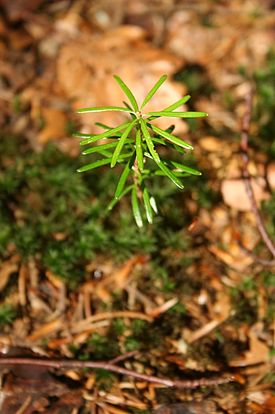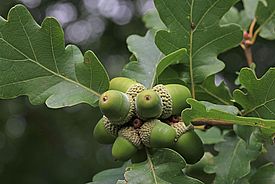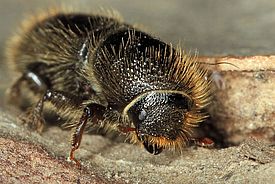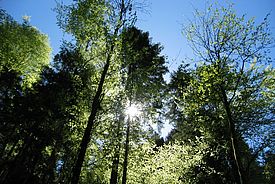22.12.2016 | News
Confronted with climate change, forests will no longer be able to maintain their performance in terms of timber production, protection against natural hazards and recreational spaces for the public. This much is clear from the results of the Forests and Climate Change research programme conducted by the Swiss Federal Office for the Environment (FOEN) and the Swiss Federal Institute for Forest, Snow and Landscape Research (WSL). And it poses a very real challenge for forest management. At the “Forum für Wissen 2016” organised by the WSL in Uitikon (Zurich) on 29 November, scientists presented their findings to more than 240 fores
Climate researchers predict that global warming will result in increasingly frequent dry spells and heavy precipitation. This will impact on forests, so how will they respond and how can forest owners prepare for this? To answer such questions and better assess the impact of climate change and forest management measures, in 2009 the Federal Office for the Environment (FOEN) and WSL launched "an unprecedented forest and climate programme", WSL Director Konrad Steffen told the “Forum für Wissen 2016”. Around 300 people working on 42 projects examined the impact of climate change on the forest and drew up forest management recommendations.
Spruce trees will struggle
Together with some colleagues, WSL researcher Niklaus Zimmermann evaluated statistical models based on the present-day occurrence of tree species and climate data. The researchers combined these statistical models with climate models and found out which tree species can thrive where in a changed climate. They concluded that in the long term spruce trees in Switzerland's central plateau will be jeopardised by drought, and that beech trees will tend to suffer too. However, the models produce different results regarding the extent of the risk to which beech trees will be exposed before the end of the 21st century wherever they occur in the central plateau. Oak trees will probably be among the winners in the medium term because they are better equipped to cope with drought. At moderately high elevations, beech and other deciduous trees will prove more competitive than in the past, compared with spruce, and slowly replace them. But Niklaus Zimmermann stressed: "the forest is changing more slowly than the models for site suitability of individual tree species are predicting. Changes typically occur more quickly after extreme events, like severe droughts or forest fires, because the forests then regenerate over large areas".
Don't panic!
Despite worrying messages from climate researchers reports, the advice from ETH Zurich Professor of Forest Ecology Harald Bugmann is: "Don't panic! Our forests still have some time left". Nonetheless, in view of the lengthy life cycles of trees, it makes sense to start implementing measures today, especially with regard to forest regeneration. Whereas forest stands will undergo hardly any major changes over the next 30 years, once that period has elapsed, change will occur rapidly, depending on altitude, with spruce trees at lower elevations suffering severely. By contrast, sub-Alpine forests managed the way they are today are forecast to grow even faster, because the rise in temperature will promote tree growth at higher elevations, which is today limited by the short growing season.
More generations of bark beetle in future
Forests will be weakened not only by gradual climate change, but also by one-off events, like pest infestations. The spruce bark beetle, which infests weakened spruce in particular, is one of the most widespread insect pests in Swiss forests. According to Beat Wermelinger, a forest entomologist at the WSL: "Global warming will probably result in an extra generation of spruce bark beetles per season, so spruce trees, especially at lower altitudes, will be more frequently infested in future". After all, a warmer climate will induce the beetles to start swarming earlier and, in time, evolve faster.
Diversity is the key
The question remaining is this: how can we keep forests functioning in a time of climate change? Peter Brang, head of the research programme, recommends that tree species which thrive in warm regions subjected to frequent droughts in forests should already also be introduced elsewhere, in mixed stands, to spread and thus reduce the risks faced. Another way of doing this might be to increase structural diversity, boost individual trees' resistance to disturbance and shorten rotation periods. "However, the objective is not to completely 'rebuild' today's forests. It makes more sense to 'tweak' their management, aiming to achieve a smooth change of tree species." And genetic diversity ought to be kept as high as possible. "Where spruce and beech are concerned, the researchers were able to show that depending where they grow, these species display genetic differences regarding properties like budding and height growth", Andrea Pluess reported. Forest managers can exploit this by taking saplings that are already better adapted to a hot, dry climate today. In view of the many uncertainties remaining, Brang advocates adaptive forest management, which entails steadily improving management measures by learning all the time.
Foreign tree species also help to spread risks
Compared to today, the composition of tree species in Swiss forests will probably change substantially by the end of the 21st century. Oaks and in certain locations also pines and silver firs are not the only indigenous alternatives to spruce and beech trees displaced to higher elevations. However, as several participants pointed out, intensive browsing by game makes it difficult for oak and fir trees to grow. The diversity of Swiss forests could also be enhanced by including either rare species or species previously regarded as being of lesser interest, such as the wild service tree, lime tree and forest cherry tree. But more room could also be given to foreign tree species like the Douglas fir, which already occurs in Switzerland. This non-native conifer is drought-resistant, grows rapidly and yields high-quality timber. "There should be no taboo about planting Douglas firs in Switzerland. It may be a viable alternative to deforestation in Siberia or the Amazon", says Andreas Rigling, head of the WSL's Forest Dynamics Research Unit. Nonetheless, he stressed that this species should not be planted in large stands or in single-species stands of the same age. Moreover, other important functions of forests, such as promoting biodiversity and providing protection against natural hazards have to be respected.
It may be unnerving for forest specialists that changes through climate change are not fully forseeable. The research programme's findings will facilitate a forest management approach that takes these developments into account. As Ueli Meier, cantonal forest engineer of Basel-City and Basel-Land, said: "Science is now giving us important decision-making aids for dealing with climate change". Meier monitored the research programme as a member of the Steering Committee. His conclusion? "The time has now come for forestry practitioners and forest owners to act."
Copyright
Copyright
WSL and SLF provide the artwork for imaging of press articles relating to this media release for free. Transferring and saving the images in image databases and saving of images by third parties is not allowed.
Links and documents
- What determines competition amongst forest trees?
- The forests of Grisons are resisting climate change
- Adapting to climate change – a major challenge for forests
- Research Programme Forests and Climate Change
- Pluess, A.R.; Augustin, S.; Brang, P. (Red.) 2016:
Wald im Klimawandel. Grundlagen für Adaptationsstrategien.
Bern, Bundesamt für Umwelt BAFU. Birmensdorf, Eidg. Forschungsanstalt WSL. Bern, Stuttgart, Wien, Haupt. 447 S.




